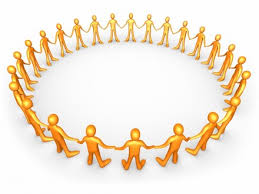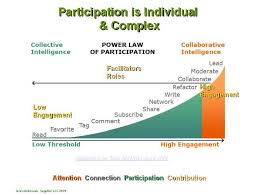 Did you see it? Did you see the front page news in USA Today Monday on Monday, April 22, 2013? The article by Hadley Malcolm was headlined “Millennials show no e-fear“. In a nutshell, this entire article boils down to one simple idea. We are going through an economic paradigm shift, and we’re moving to something economists are calling “The Participation Economy“. I believe fundraising and non-profit professionals need to pay attention because this will likely have a HUGE impact on the future of philanthropy.
Did you see it? Did you see the front page news in USA Today Monday on Monday, April 22, 2013? The article by Hadley Malcolm was headlined “Millennials show no e-fear“. In a nutshell, this entire article boils down to one simple idea. We are going through an economic paradigm shift, and we’re moving to something economists are calling “The Participation Economy“. I believe fundraising and non-profit professionals need to pay attention because this will likely have a HUGE impact on the future of philanthropy.
So, what is “The Participation Economy“? Jeff Fromm, who is a blogger at Millennial Marketing and co-author of Marketing to Millennials (ugh … how old fashion . . . a book . . . what is THAT?), really describes it well when he says in USA Today:
“They’re (millennials) willing to accept advertising, but they want something out of it. The willingness to share where we are, who we’re with, what we like with the virtual world is part of ‘the participation economy’.”
The reporter dug up some interesting data from the University of Southern California’s Center for the Digital Future:
- 25% of Millennials would trade personal info in exchange for more relevant advertising (for those of us 35+ years old only 19% agreed with this statement)
- 56% of Millennials would share their location to receive deals from nearby businesses (for those of us 35+ years old only 42% agreed with this statement)
- 51% of Millennials would share info with a company if they get something in return (for those of us 35+ years old only 40% agreed with this statement)
Consumers are willing to “participate” if they get something in return, and this especially applies to younger consumers (aka people who will have the money in the not-so-distant-future).
 Looking at this from a different angle, people are willing to ENGAGE if they get something in return.
Looking at this from a different angle, people are willing to ENGAGE if they get something in return.
If you want more proof, I suggest that you turn on your television set. The shows that people tune into most are participatory (e.g. American Idol, The Voice, etc).
What does any of this have to do with your non-profit and your resource development program? Well, here are just a few of my thoughts:
- Millennials live their lives in both the physical world as well as in the virtual world. Fundraising programs will need to set-up shop in both spaces in the future.
- Ten years ago, many of my fundraising colleagues warned against over-investing in ePhilanthropy strategies because Millennial donors were young and years away from participating in serious philanthropy. Well, the oldest Millennials are now 34-years-old. Uh-oh! I think “the future” is knocking on the door. It might be time to get serious about what ePhilanthropy looks like and what strategies and tactics are effective.
- The idea of PARTICIPATION holds the key to engagement for this up-and-coming generation of philanthropists. So, it stands to reason that if you want Millennials to take the place of their Baby Boomer parents over the next 10 years, then your resource development program can’t simply treat donors like Cash Station machines (ATM). We need to get beyond the “you ask and then you get” mentality. We need to shift our paradigm to “you involve, you ask, they give, and they stay involved“.
At first blush, we’re obviously talking about volunteerism being the key to engaging the next generation and developing your future base of donors. Here are a few interesting resources for those of you who understand that you have some work to do around strengthening your agency’s volunteer recruitment and management program:
- http://www.volunteeringinamerica.gov/rankings/States/Millennial-Volunteer-Rate/2011
- http://www.mavanetwork.org/Default.aspx?pageId=965113
- http://digitalcommons.kennesaw.edu/cgi/viewcontent.cgi?article=1448&context=etd
However, I think focusing on your volunteer recruitment, management and retention program and strategies is just the tip of the iceberg.
 Here is a crazy thought out of left field. What if you and a handful of Millennial aged supporters sat down and asked the question: “How do we build great participation (both physical and virtual) strategies into our resource development program?” Here are a few wacky questions and ideas to chew on:
Here is a crazy thought out of left field. What if you and a handful of Millennial aged supporters sat down and asked the question: “How do we build great participation (both physical and virtual) strategies into our resource development program?” Here are a few wacky questions and ideas to chew on:
- How can your agency partner with the business community to entice Millennial consumers (aka donors) to “check-in” on Facebook or Foursquare at a local business. What benefit will the business get out of it? What benefit will your agency get out of it? What benefit will the consumer (aka donor) get out of it? How can the business and your agency share that data? What will you do with it once you have it? For some reason, I am envisioning a scavenger hunt fundraiser. I am also envisioning passports with QR codes linked to YouTube videos containing clues, instructions and cultivation/stewardship info.
- How can you get your Millennial aged donors to participate in the act of allocating where their donation goes? Are we at the threshold of entering “The Restricted Gift” era? What can you do to involve donors as volunteers in programs that their contribution helps support?
- What tools will your fundraising volunteers need in their toolbox if they are going to evangelize you mission online and solicit people in the virtual world? Will those strategies need to look different than the current structured campaigns we’ve been running in the physical world? If so, what accountability and urgency strategies will fundraising professionals need to develop in order to drive productivity?
Does your head hurt? I know mine does. So, let’s focus on one simple question: “What two or three things can you and your agency do to start transitioning your resource development program into alignment with the new ‘Participation Economy’?” Please scroll down and share a few thoughts in the comment box below.
Here’s to your health!
Erik Anderson
Founder & President, The Healthy Non-Profit LLC
www.thehealthynonprofit.com
erik@thehealthynonprofit.com
http://twitter.com/#!/eanderson847
http://www.facebook.com/eanderson847
http://www.linkedin.com/in/erikanderson847

One comment